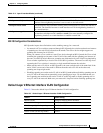
13-16
Catalyst 2940 Switch Software Configuration Guide
78-15507-02
Chapter 13 Configuring VLANs
Configuring VLAN Trunks
Defining the Allowed VLANs on a Trunk
By default, a trunk port sends traffic to and receives traffic from all VLANs. All VLAN IDs, 1 to 1005,
are allowed on each trunk. However, you can remove VLANs from the allowed list, preventing traffic
from those VLANs from passing over the trunk. To restrict the traffic a trunk carries, use the switchport
trunk allowed vlan remove vlan-list interface configuration command to remove specific VLANs from
the allowed list.
To reduce the risk of spanning-tree loops or storms, you can disable VLAN 1 on any individualized
VLAN trunk port by removing VLAN 1 from the allowed list. This is known as VLAN 1 minimization.
VLAN 1 minimization disables VLAN 1 (the default VLAN on all Cisco switch trunk ports), on an
individual VLAN trunk link. As a result no user traffic, including spanning-tree advertisements, are sent
or received on VLAN 1.
When you remove VLAN 1 from a trunk port, the interface continues to send and receive management
traffic, for example, Cisco Discovery Protocol (CSP), Port Aggregation Protocol (PAgP), Link
Aggregation Control Protocol (LACP), Dynamic Trunking Protocol (DTP), and VLAN Trunking
Protocol (VTP) in VLAN 1.
If a trunk port with VLAN 1 disabled is converted to a nontrunk port, it is added to the access VLAN.
If the access VLAN is set to 1, then the port is added to VLAN 1, regardless of the switchport trunk
allowed setting. The same is true for any VLAN that has been disabled on the port.
A trunk port can become a member of a VLAN if the VLAN is enabled, if VTP knows of the VLAN,
and if the VLAN is in the allowed list for the port. When VTP detects a newly enabled VLAN and the
VLAN is in the allowed list for a trunk port, the trunk port automatically becomes a member of the
enabled VLAN. When VTP detects a new VLAN and the VLAN is not in the allowed list for a trunk
port, the trunk port does not become a member of the new VLAN.
Beginning in privileged EXEC mode, follow these steps to modify the allowed list of an 802.1Q trunk:
To return to the default allowed VLAN list of all VLANs, use the no switchport trunk allowed vlan
interface configuration command.
Command Purpose
Step 1
configure terminal Enter global configuration mode.
Step 2
interface interface-id Enter interface configuration mode and the port to be configured.
Step 3
switchport mode trunk Configure the interface as a VLAN trunk port.
Step 4
switchport trunk allowed vlan {add |
all | except | remove} vlan-list
(Optional) Configure the list of VLANs allowed on the trunk.
For explanations about using the add, all, except, and remove keywords,
refer to the command reference for this release.
The vlan-list parameter is either a single VLAN number from 1 to 1005
or a range of VLANs described by two VLAN numbers, the lower one
first, separated by a hyphen. Do not enter any spaces between
comma-separated VLAN parameters or in hyphen-specified ranges.
All VLANs are allowed by default.
Step 5
end Return to privileged EXEC mode.
Step 6
show interfaces interface-id switchport Verify your entries in the Trunking VLANs Enabled field of the display.
Step 7
copy running-config startup-config (Optional) Save your entries in the configuration file.


















